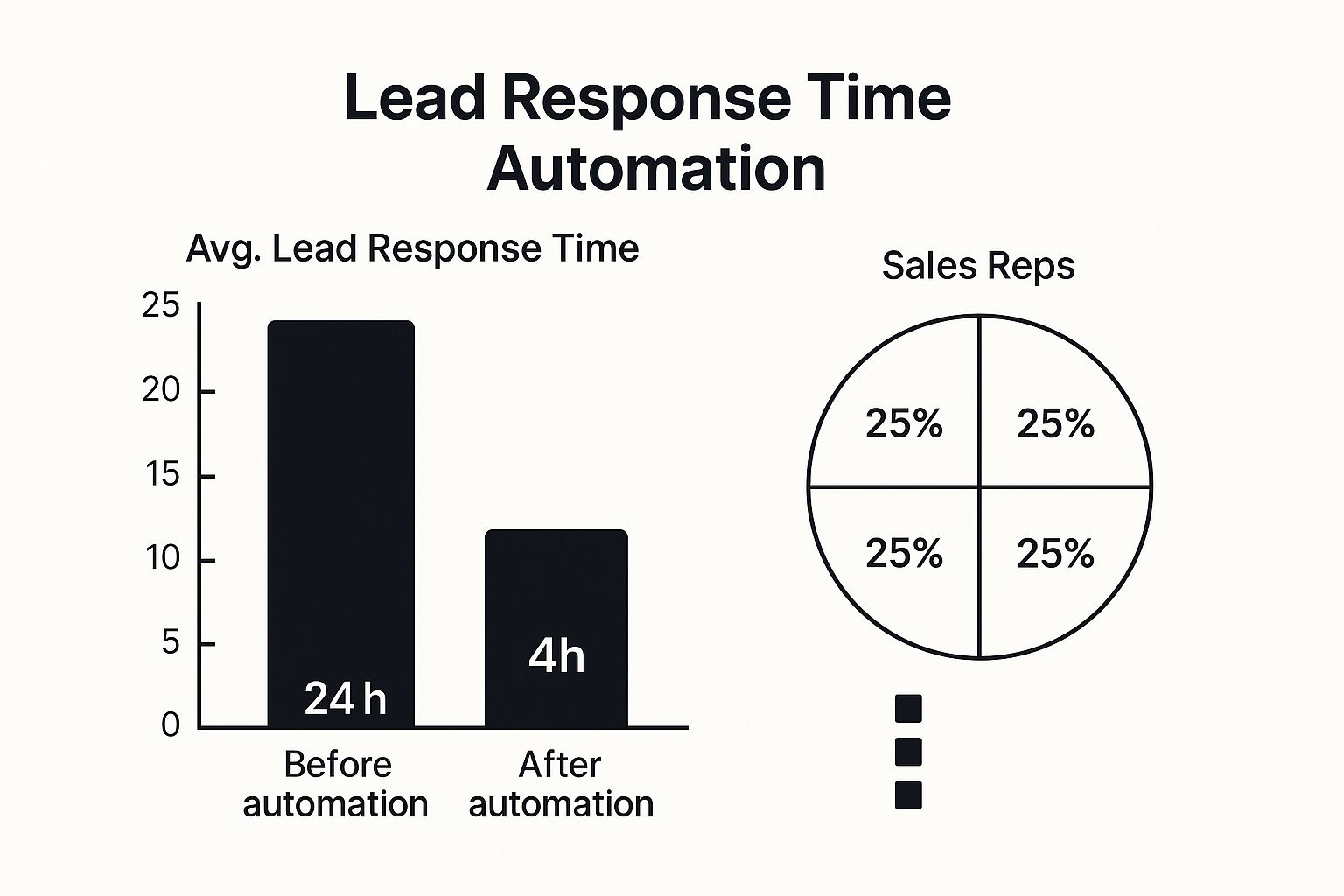Understanding California's Automated Lead Distribution Landscape

California's competitive business world, particularly in the tech industry, requires speed and efficiency. This makes automated lead distribution essential for growth. Imagine leads as valuable opportunities. Manual lead assignment is slow and prone to errors, like a dropped ball. Automated distribution, however, instantly connects leads with the right sales representative, maximizing your chances of success.
Challenges Faced by California Businesses
California businesses face specific hurdles that automated lead distribution can overcome.
- Fierce Competition: California is a hotbed for startups and established companies, creating a competitive marketplace. Automated distribution allows businesses to respond to leads quickly, gaining a competitive advantage.
- Rapidly Changing Markets: California's markets are constantly evolving. Automated systems offer the flexibility to adjust lead routing rules instantly, keeping up with market demands.
- High Volume of Leads: Rapid growth often means a flood of leads. Manual management becomes overwhelming. Automation provides the scalability to handle this influx efficiently.
This requires California businesses to be nimble and responsive. Adopting automated lead distribution practices provides the needed speed and precision. This process is key to improving sales performance, especially in California's tech-savvy business landscape. While specific historical data for California is limited, using CRM automation like HubSpot is known to boost lead conversion. Businesses employing CRM automation typically see increased lead conversion, though fully automated customer journeys are less common, occurring in only about 10% of cases. This highlights the growth potential for California's tech sector through automation. California companies using automation can streamline lead distribution within their CRM systems, assigning leads based on location for more effective sales outreach. Find more statistics here: https://www.cazoomi.com/blog/50-marketing-automation-statistics-you-need-to-know-in-2025-and-beyond/
Benefits of Automation
Automating lead distribution provides significant advantages:
- Faster Response Times: Leads are routed instantly to the correct sales representative, leading to quicker follow-ups and happier customers.
- Fair Workload Distribution: Automation eliminates manual assignment bias, ensuring a balanced distribution of leads across the sales team and improving morale.
- Reduced Territorial Disputes: Clear rules within the automated system minimize conflicts over lead ownership, allowing sales reps to focus on selling.
- Improved Lead Conversion Rates: Connecting leads quickly with the most qualified rep increases the likelihood of closing deals.
Automated lead distribution helps sales teams work smarter. By eliminating manual tasks and streamlining lead management, businesses can reach their full sales potential.
Building Your Automated Distribution System From Scratch

Building a successful automated lead distribution system requires a strong understanding of your sales team's structure, territory assignments, and the definition of a qualified lead within your industry. This knowledge helps create a system that provides long-term benefits. For example, lead qualification and territory assignments will differ significantly between a solar panel company in Southern California and a telecommunications provider in Northern California.
Defining Your Ideal Lead and Team Structure
First, define your ideal customer profile (ICP). Consider their demographics, needs, and pain points. Understanding your ICP helps identify leads most likely to become paying customers. Next, analyze your sales team’s structure. Consider if you have specialized representatives for specific products or geographic areas. For example, a sales rep might excel at selling home security systems but struggle with smart home devices. Understanding these nuances allows you to connect leads with the most suitable sales reps. You might be interested in: How to master...
Establishing Clear Distribution Rules
Create specific distribution rules based on your team and ICP. These rules should be clear and easy to implement within your chosen software. Factors like lead source, expressed product interest, company size, or even the time of day the lead was generated can be incorporated into your rules. Location-based routing is often crucial for businesses in California due to the state's diverse geography. Leads from Los Angeles would be routed to reps covering that area, while leads from San Francisco would be directed to a different team.
Additionally, establish clear service level agreements (SLAs) for response times. Determine how quickly a rep should contact a new lead to ensure timely follow-up and improve conversion chances. A lead scoring system can also prioritize high-value leads. Assigning points based on factors like engagement level or budget allows your system to automatically prioritize the most promising leads, ensuring they receive immediate attention.
Connecting Lead Sources and Workflow
Integrate all your lead sources into a single workflow. This could include your website, social media platforms, third-party lead generation services, and referral programs. Centralizing your lead sources streamlines the process and ensures no leads slip through the cracks. Think of it as a central hub for all incoming leads, regardless of their origin.
Technical Setup and Backup Procedures
When setting up your chosen software, ensure it integrates seamlessly with your existing CRM and other sales tools. Thoroughly test the system and establish backup procedures in case of technical issues. This preparation helps prevent lost leads and ensures smooth, continuous operation. Regular data backups are crucial, especially for California businesses potentially affected by natural disasters.
Monitoring, Accountability, and Optimization
Finally, implement accountability measures to ensure the system operates effectively. Track key performance indicators (KPIs) like lead response time, conversion rates by rep, and the overall effectiveness of your distribution rules. Use this data to continuously optimize your system. For example, if a particular lead source underperforms, you can adjust your qualification process or distribution rules. Regularly review and adjust your system’s performance for optimal results. This ongoing optimization maximizes the effectiveness of your automated lead distribution system and ensures its continued success.
Maximizing Conversions Through Smart Lead Assignment

Automated lead distribution becomes significantly more effective with smart assignment strategies designed to boost revenue. This isn't just about assigning leads round-robin style. Instead, top-performing companies leverage data-driven methods to connect the right leads with the best sales representatives, maximizing each lead's potential.
Dynamic Assignment Algorithms
Think of dynamic assignment algorithms as intelligent matchmaking for your sales team. These algorithms consider several factors when routing leads.
- Rep availability
- Current workload
- Specific expertise
- Past performance with similar prospects
For example, a lead from a large enterprise in the tech sector might be routed to a rep with a proven track record of closing similar deals. This personalized routing significantly increases conversion chances.
Leveraging behavioral data and lead source information helps predict effective sales strategies. This data-driven approach is the core of smart assignment. By understanding a lead’s online behavior, such as website visits and content downloads, you can tailor the sales process to their specific interests.
The strategic use of automated lead generation tools can significantly impact conversion rates. Companies using these systems can see increases of over 50%. This is particularly relevant in today’s competitive market. Learn more about automated lead generation here: Automated Lead Generation Guide
Using Prospect Characteristics and Engagement History
You can create effective assignment rules by considering several key factors.
- Prospect characteristics
- Engagement history
- Buying signals
For example, a lead visiting your pricing page multiple times and downloading a product brochure demonstrates high purchase intent. This lead should be immediately routed to a qualified sales rep for prompt follow-up, improving your conversion rates.
Creating Predictable Revenue Streams
These data-driven strategies shift you from simply managing leads to actively shaping your revenue pipeline. Assigning the right leads to the right reps at the right time creates more predictable revenue and empowers sales teams to perform at their best. Learn more about effective lead routing: How to Master Lead Routing. This strategic approach maximizes conversions and drives sustainable business growth.
Choosing The Right Tools For Your Distribution Success
Selecting the right tools for automated lead distribution can significantly impact your sales success. Let's explore key features to consider when evaluating different platforms and software options available to California businesses. This includes popular CRM platforms, specialized lead routing software, and crucial integration capabilities.
Essential Features For Effective Distribution
When evaluating tools, prioritize features that directly improve your sales operations.
- Real-Time Assignment: Instant lead routing ensures quick responses and maximizes engagement while leads are still hot. This is especially important in fast-paced markets like California's.
- Mobile Notifications: Empower your field sales teams with real-time updates and lead information sent directly to their mobile devices. This feature is crucial for representatives constantly on the move.
- Reporting Dashboards: Gain clear insights into your distribution performance. Identify bottlenecks and track key metrics with comprehensive dashboards, allowing for data-driven decision-making and continuous improvement.
- API Connectivity: Seamless integration with existing systems like your CRM and other sales tools avoids data silos and streamlines your workflows.
These core features are essential for any successful automated lead distribution system. Finding a tool that excels in these areas is a strong starting point.
Evaluating Platforms For Different Business Needs
Different businesses have unique needs and budgets. Selecting the right platform depends on factors like your business size, sales team structure, and growth plans.
- Budget-Friendly Solutions: For growing businesses, cost-effective options often focus on core features like lead routing and basic reporting.
- Enterprise-Grade Platforms: Larger organizations require advanced features like complex routing rules, custom integrations, and in-depth analytics.
Consider your current needs and future scalability when selecting a platform. Don't overspend on features you don't need now, but also ensure the platform can grow with your business. You might be interested in: 10 Best Lead Management Software for Sales Teams in 2025
Insights From California Businesses
California businesses have valuable insights into the practicalities of automated lead distribution. Common challenges include implementation complexities, unforeseen costs, and identifying the most impactful features. Choosing a platform with strong customer support and clear documentation can ease the implementation process and avoid frustration. Additionally, look for transparent pricing models and avoid hidden fees.

This infographic visualizes the impact of automation, comparing lead response times before and after implementation and demonstrating how leads are distributed equally among sales reps. Automated lead distribution drastically reduces response time from 24 hours to 4 hours, enabling faster follow-up and improving conversion potential. The even 25% distribution across sales representatives ensures fair workload allocation and increased team efficiency.
The following table provides a comparison of several lead distribution platforms:
Lead Distribution Platform Comparison: Comprehensive comparison of leading automated lead distribution platforms, featuring pricing, key capabilities, and ideal business sizes
table block not supported
This table summarizes key features, pricing models, and ideal business sizes for several popular lead distribution platforms. Choosing the right platform requires careful consideration of your specific business needs and budget.
Finding a platform tailored to your business needs and the California market will significantly contribute to long-term success. This includes considering mobile accessibility for field sales teams, integration with existing CRMs, and specialized features for managing territories and diverse customer demographics across the state. Careful planning and tool selection pave the way for successful automated lead distribution.
Generating More Qualified Leads Through Marketing Automation
Effective automated lead distribution starts with attracting the right prospects. Let's explore how successful California businesses create integrated marketing and sales automation workflows that generate valuable leads. This involves improving lead quality from the beginning using strong qualification tactics, unobtrusive progressive profiling, and behavioral tracking to identify real buying interest.
Qualifying Leads at the Source
Imagine a California solar company generating leads through online inquiries and home shows. A simple contact form captures basic information. However, a more detailed qualification process during the initial contact can greatly enhance lead quality. For example, asking about roof type, energy consumption, and budget upfront allows the system to pre-qualify leads. This ensures the right sales team receives the lead, preventing wasted time on unlikely conversions.
Progressive Profiling and Behavioral Tracking
Instead of overwhelming prospects with long forms, consider progressive profiling. This approach gradually collects more information as the prospect interacts with your brand. Imagine a San Francisco telecommunications provider offering various internet packages. Progressive profiling gathers information step-by-step. The first form might ask about their current provider. The next might focus on speed preference. A third could inquire about additional services like phone or television bundles. This respects the prospect's time while improving lead qualification and enabling personalized follow-ups. This targeted information also empowers your automated lead distribution system for accurate lead routing.
Behavioral tracking provides further insights into genuine buying intent. Monitoring website activity, email engagement, and content downloads reveals a prospect’s true interest. This serves as a valuable trigger in your automated lead distribution system. For instance, a prospect frequently visiting product comparison pages or downloading pricing guides signifies high purchase intent. The system can then prioritize and distribute this lead to a sales representative specializing in closing high-value deals.
Lead Nurturing and Automated Distribution
Lead nurturing sequences prepare prospects for productive sales conversations. Imagine a Los Angeles home services company specializing in kitchen renovations. An automated email sequence could provide valuable content. This might include renovation checklists, design inspiration, and customer testimonials. This process builds trust and positions the company as an expert, gently guiding the prospect towards a sales conversation. These nurturing sequences can automatically trigger lead distribution based on engagement and buying signals. For example, if a prospect clicks a specific link in a nurturing email or downloads a case study, the system can instantly route the lead to a specialist.
In California, with its high tech adoption rate, using marketing automation software (APSIS) can drastically improve lead capture. For example, employing this software can lead to a 45.1% increase in qualified leads. This statistic emphasizes automation’s power in tech-forward regions. By integrating AI and CRM systems, California businesses can optimize lead distribution. Leads are routed effectively based on factors like geographic location or lead source. This approach improves customer engagement and streamlines sales operations. Learn more about lead capture statistics here: Find more detailed statistics here.
Optimizing for Sales-Ready Prospects
Optimizing your lead capture forms, landing pages, and multi-channel campaigns is essential. A clear call to action on your landing page, coupled with a concise lead capture form, increases conversion rates. Using multi-channel campaigns incorporating social media, email marketing, and targeted advertising expands your reach. By consistently testing and refining these elements, you create a steady flow of qualified leads. Your automated distribution system can effectively convert these leads into revenue. This creates a powerful synergy between marketing and sales, ensuring each lead represents a genuine business opportunity.
Measuring What Matters And Optimizing For Growth
Data without action isn't very useful. This section explores how California businesses can leverage automated lead distribution to boost sales performance. We'll dive into important key performance indicators (KPIs) like lead response time, conversion rates, and individual rep performance, providing practical ways to track and utilize this data for growth.
Essential KPIs for Automated Lead Distribution
Understanding the right KPIs is the first step towards optimization. Here's what to focus on:
- Lead Response Time: A quick response to new leads is crucial. The faster your team connects, the higher the chance of engaging a prospect before they look at the competition.
- Conversion Rates by Assignment Method: Analyze conversions based on how leads are assigned. Methods like round-robin, skill-based, and territory-based routing each have their own strengths. This data will help you fine-tune your distribution rules.
- Sales Rep Performance Variations: Tracking individual performance helps identify top performers and areas for team improvement. Maybe a specific training program or mentorship could boost performance for certain reps.
- Lead Source Effectiveness: Different lead sources produce different results. Knowing which sources generate the highest quality leads (like website forms, social media, or referrals) allows you to strategically allocate marketing resources.
To effectively track your progress and identify areas for improvement, consider the following metrics and benchmarks:
Lead Distribution Performance Metrics: Essential KPIs and benchmarks for measuring automated lead distribution effectiveness and ROI
table block not supported
This table provides a framework for analyzing lead distribution performance. By regularly reviewing these metrics, you can identify areas for improvement and optimize your strategies.
Setting Up Actionable Reporting Systems
Effective reporting provides clear insights. Focus on visualizing these KPIs in easy-to-understand dashboards. This helps identify trends and potential issues quickly. For example, a drop in conversions from a specific lead source could signal a problem with your lead qualification process.
